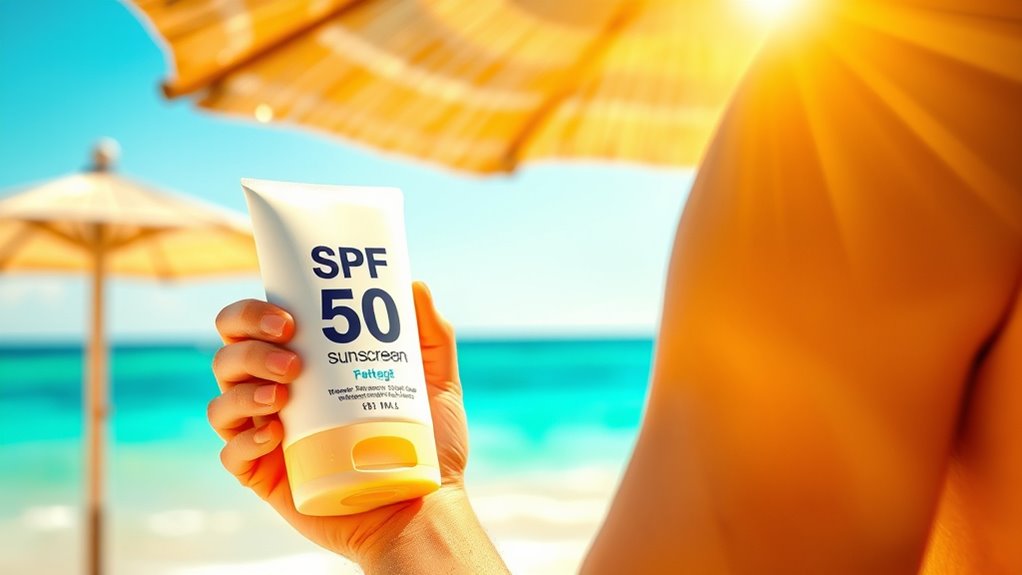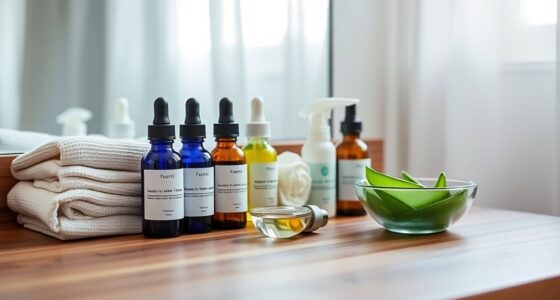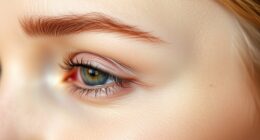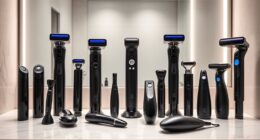SPF ratings show how well a sunscreen blocks UVB rays in lab tests, but real-world protection depends on how you apply and reapply it. Applying less than enough or missing spots reduces its effectiveness. Reapplying every two hours, especially after swimming or sweating, is essential. Remember, broad-spectrum sunscreens protect against UVA rays too. To truly prevent UV damage, understanding these factors helps you get the most out of your sunscreen—if you keep exploring, you’ll find out more.
Key Takeaways
- SPF ratings are based on lab tests and indicate UVB protection, not overall real-world effectiveness.
- Proper application and reapplication are crucial; high SPF alone doesn’t guarantee full protection.
- Real-world factors like sweating, swimming, and missed spots reduce sunscreen’s effectiveness.
- Broad-spectrum sunscreens protect against UVA and UVB rays, offering more comprehensive protection.
- Adequate coverage, correct application, and frequent reapplication are essential for effective sun protection.
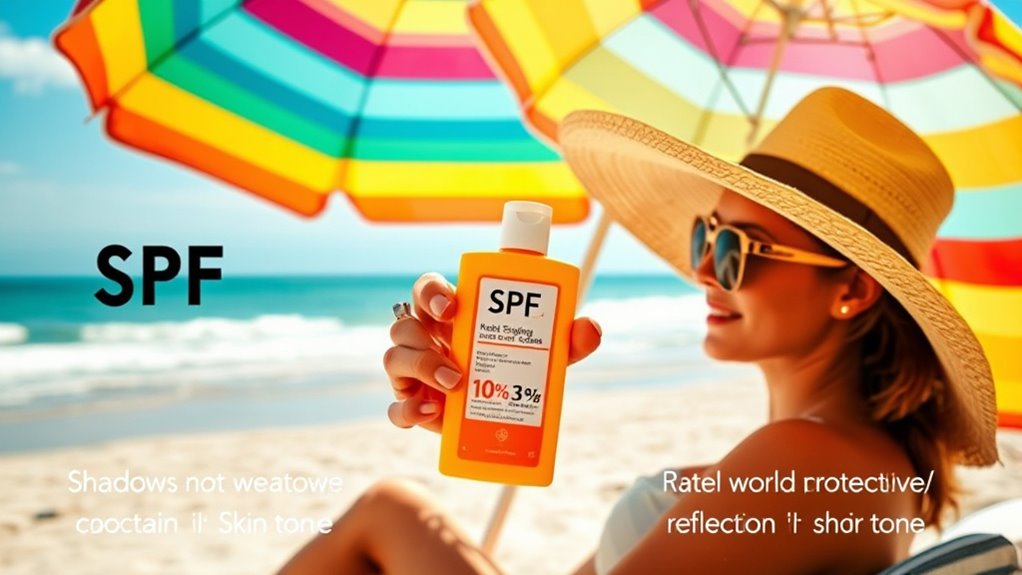
Understanding SPF ratings is essential for protecting your skin from harmful UV rays. SPF, or Sun Protection Factor, indicates how well a sunscreen can shield you from UVB rays, which are primarily responsible for sunburn and skin damage. However, the number alone doesn’t tell the whole story about how much UV penetration occurs or how effective your protection really is. It’s important to realize that SPF ratings are based on laboratory tests under controlled conditions, not real-world situations. When you apply sunscreen, the effectiveness depends heavily on proper sunscreen application and consistent reapplication, especially when you’re outdoors for extended periods.
One common mistake is underestimating how much sunscreen you need. Many people don’t apply enough, which *substantially* reduces the SPF’s effectiveness. To maximize protection, you should use about one ounce (a shot glass full) for full-body coverage and make sure to cover all exposed skin evenly. Remember, the thinner the layer, the more UV penetration there is. If you miss spots or don’t apply enough, UV rays can penetrate your skin more easily than the SPF rating suggests. This is why, despite using a high-SPF product, improper application can leave you vulnerable to sun damage.
Applying less than one ounce of sunscreen greatly reduces its effectiveness.
Another factor that influences your actual protection is how often you reapply sunscreen. Even the best sunscreen won’t last all day if you don’t reapply at least every two hours, or more often if you’re swimming or sweating. Water, towel drying, and rubbing can remove sunscreen from your skin, reducing its ability to block UV rays. This ongoing process of reapplication helps maintain a *substantially* consistent level of protection, reducing UV penetration over time.
It’s also important to understand that SPF ratings don’t account for all types of UV rays. While they primarily measure UVB protection, UVA rays also contribute to skin aging and some skin cancers. Broad-spectrum sunscreens protect against both UVA and UVB rays, providing more *extensive* coverage. When you choose a sunscreen, check for broad-spectrum labels and ensure you’re applying enough of it to achieve the SPF protection promised on the label.
In the real world, your protection depends on more than just the SPF number; it depends on your sunscreen application, reapplication, and how effectively you shield your skin, especially during peak UV hours. Additionally, proper sunscreen storage can affect its efficacy, as exposure to heat and sunlight can degrade its protective properties. Being mindful of these factors ensures you’re better protected from UV penetration and the long-term damage it can cause.
Frequently Asked Questions
How Often Should I Reapply Sunscreen During Outdoor Activities?
You should reapply sunscreen every two hours during outdoor activities to maintain effective protection. Sunscreen reapplication is essential, especially if you’re sweating or swimming. Follow your outdoor protection schedule by applying it generously before going outside, then reapply as needed. Keep in mind that even broad-spectrum sunscreens with high SPF need frequent reapplication to guarantee continuous defense against UV rays, helping prevent sunburn and long-term skin damage.
Does Higher SPF Mean Better Protection Against All Types of UV Rays?
Imagine your skin as a delicate canvas, vulnerable to the sun’s harsh rays. Higher SPF might block more UV penetration, but it doesn’t guarantee protection against all UV rays, especially if your skin is sensitive. While it can help shield you from UVB rays, UVA rays still penetrate, affecting your skin over time. So, a higher SPF isn’t always better; choose broad-spectrum protection and reapply often for real-world safety.
Can Sunscreen With High SPF Prevent Skin Aging Effectively?
You might wonder if high SPF sunscreen effectively prevents skin aging. While higher SPF offers better UVB protection, SPF efficacy alone doesn’t fully prevent skin aging, which also involves UVA rays. To better combat skin aging, choose broad-spectrum sunscreens with high SPF, reapply regularly, and combine with other sun protection measures like seeking shade and wearing protective clothing. Remember, consistent use is key to maintaining youthful skin.
Are Mineral Sunscreens More Effective Than Chemical Ones in Real-World Use?
When choosing between mineral and chemical sunscreens, you should consider ingredient efficacy and how they perform in real-world use. Mineral sunscreens, which contain zinc oxide or titanium dioxide, often provide broad-spectrum protection and are less likely to cause irritation. Chemical sunscreens, using ingredients like avobenzone or oxybenzone, absorb UV rays efficiently but may be less stable or cause sensitivities. Your choice depends on your skin type and activity.
How Does Water Resistance Impact Actual Sun Protection During Swimming?
Oh, the irony—water-resistant sunscreen promises waterproof durability, yet many find their swimming sunscreen fades faster than expected. During swimming, your actual sun protection depends heavily on this feature. It’s designed to stay on longer, but prolonged immersion can still weaken its barrier. So, if you want reliable coverage, choose a high-quality, waterproof sunscreen and reapply after swimming, because no sunscreen is truly invincible in water.
Conclusion
So, don’t just rely on SPF numbers—they’re like tiny shields trying to fend off an army of relentless, blazing suns. If you think SPF 30 is enough, imagine a fortress protecting you from a fiery dragon’s breath. The truth? No sunscreen can block every ray, so slather it on generously and wear protective clothing. Otherwise, you risk turning into a crispy, sun-damaged pumpkin, all because you underestimated the sun’s fiery fury!
